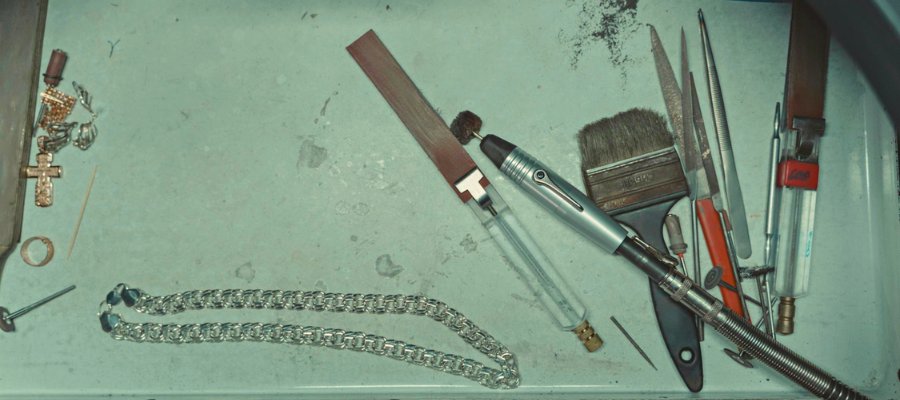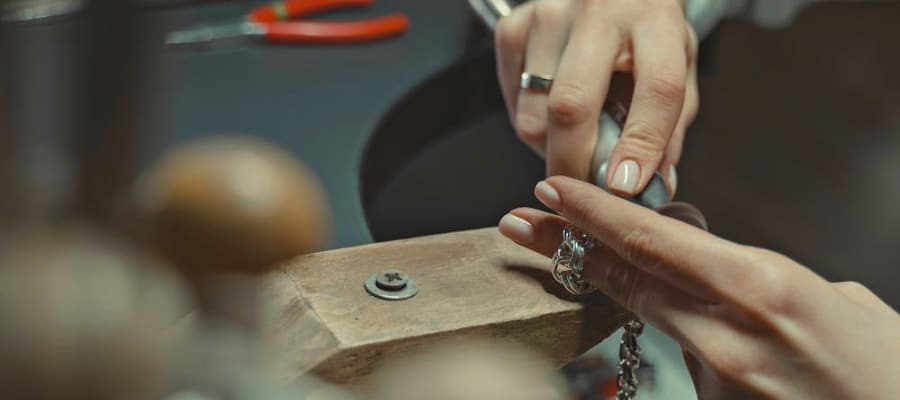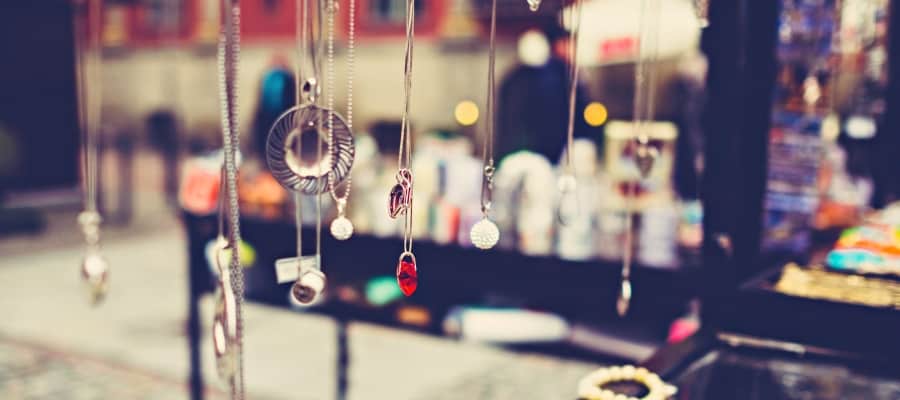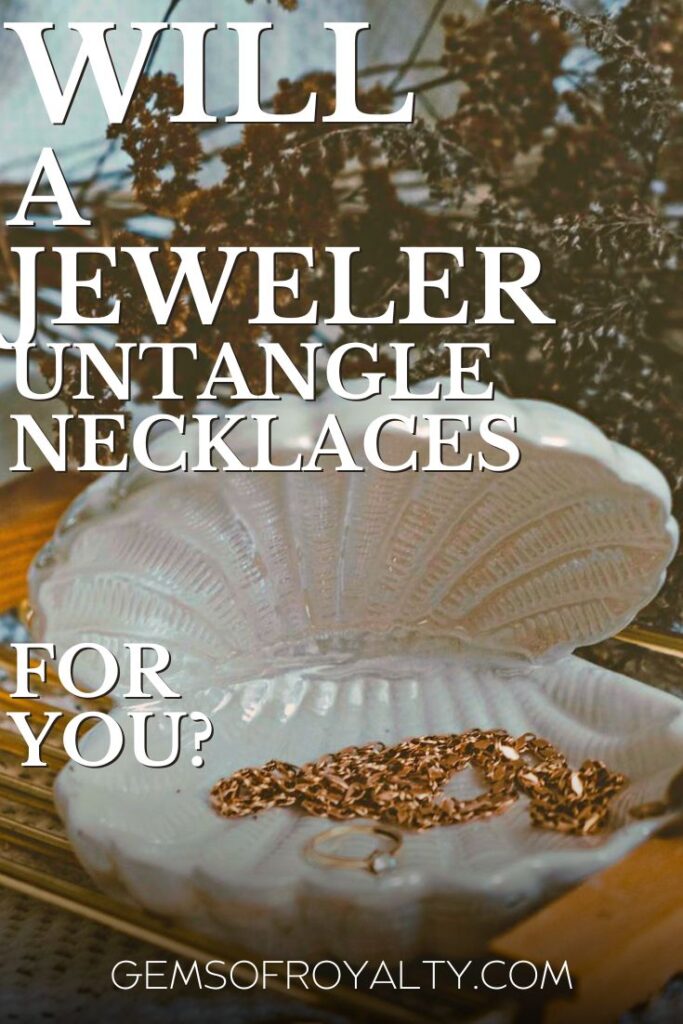We’ve all been there. You open your jewelry box to find that one necklace that you love, just to find that it is a knotted mess. After many minutes of unsuccessful untangling, you may wonder what options you have.
A jeweler will untangle a necklace for you. They have many tools for working with even small, delicate necklaces that require patience to untangle. If you can’t do it on your own or worry you may harm the necklace, take it to a jeweler.
Let’s talk more about untangling necklaces and what you can expect when taking them to a jeweler.
How Much Does It Cost To Have a Necklace Untangled?

While the price may vary based on the jeweler and the necklace, it will cost you less than $20 to have your necklace untangled. This will vary depending on where you go, how long it takes, and if it needs repairs.
It may cost you more than this if the jeweler needs to repair your necklace. This can happen if you attempt to untangle the necklace too harshly and cause damage to the chain. You may notice this with necklaces that have dainty or thin chains. Unfortunately, you can damage the chain or even break it altogether.
If you damage the chain, the jeweler can help with that too. The necklace chain allows the jeweler to easily remove broken links and reconnect them. They can also glue the necklace back together with a metal alloy if necessary. A jeweler has the right tools to untangle your necklace and repair it while you are there.
How Does a Jeweler Untangle a Necklace?

Jewelers have plenty of tools that we don’t, which allow them to untangle jewelry safely and more effectively. They are used to working with small, delicate jewelry pieces that we may find challenging. So, jewelers have the ability to carefully untangle any necklace.
Jewelers have pliers of many different sizes that can help with this. They will be able to find a tool small enough to untangle a necklace without damaging it. For tiny knots, they also have magnifying glasses that help them more clearly see the problem and handle it more precisely.
For the smallest knots, jewelers even have needles that they can use to pry the chain apart. Once they have the chain untangled, they can also use these tools to make any repairs you may need.
If your necklace chain is very small, you may have damaged it while trying to get the knot out. If this is the case, you may not notice, depending on how small it is. Left alone, this could cause the chain to break later on, which means you could lose the necklace altogether if you are wearing it when this happens.
So, the jeweler will probably want to inspect the necklace chain before they finish, as they can look at it under a magnifier to notice any breaks or imperfections. If they do, it is a good idea to have them repair the necklace right away to avoid a total break.
For larger chains, the jeweler may be able to remove damaged links and reattach the necklace to the remaining links to prevent future breakage. While this will slightly change the length of the chain, it is still helpful in not allowing any further damage to the necklace. Alternatively, the jeweler may use a soft metal alloy as a glue to hold the chain together.
Remember, if the jeweler needs to repair your necklace after untangling it, they may charge you more. So, make sure you ask if there will be an additional charge for the repair and get an estimate.
How To Untangle a Necklace

Now that we know the options for consulting a jeweler, let’s talk about some methods of untangling a necklace that may help you avoid a trip.
Unclasp the Necklace and Remove the Pendant
While it can be tempting to pick up your necklace and just start picking at the knot, there are some things you should do to make it easier. First, make sure you unclasp your necklace. This will allow you to easily control the chain and work out the knot. Once the knot is loose, you can pull it apart without stopping and unclasp the necklace before continuing.
In addition to unclasping the necklace, you should also remove the pendant on your necklace if possible. While you can’t always remove pendants from a necklace depending on the construction, we recommend doing it if you can. This will make it easier for you to move the chain around and manipulate it as needed.
Removing the pendant also allows you to keep it safe. You can damage the pendant if you drop your necklace when trying to untangle it. It also prevents you from losing the pendant if it were to fall off the chain while you are untangling it. So, unclasp the chain and remove the pendant to simplify the untangling process.
Use a Small Sharp Object
This tip can vary depending on what you have available in your home, but you will need something small and sharp to better get the job done. If you have a sewing needle, that will work best. However, a tiny screwdriver, a small nail, or a safety pin will also help you out. Use more than one if you have a spare.
Ensure you are careful with whichever tool you use, as you don’t want to accidentally poke yourself with it. Insert these sharp objects into the knot to help you pry it apart. This is especially useful with small or dainty chains that are difficult to grasp in your fingers.
Try a Lubricant
If you are still having trouble untangling your necklace, we recommend using a lubricant to help you. Only do this if you have tools to help you rather than just working with your hands, as it will make the chain slippery and more difficult to grasp.
You can use whatever you have available to you. Baby oil, coconut oil, and cooking oil are some of the most commonly used lubricants. You only need a small amount of whichever lubricant you choose, and you should only apply it to the knot, not the entire chain.
The lubricant will help you free the knot more easily, especially if the knot is tight. When chains knot, they can become tight either by themselves over time or as we pull on them, attempting to loosen the knot. So, use a small amount of lubricant to help the necklace untangle more easily.
Baby Powder
While lubricant can be helpful, some more dire steps may be necessary if you are still struggling. This is where the baby powder can help. Now, you may be wondering how dry powder can help this situation, but it is quite simple. When a chain tangles and as we attempt to loosen it, this can cause friction.
Friction in a chain can make the knot much harder to get out because it causes the links to stick together with force. Using baby powder can help release the friction between the links and allow you to separate the knot.
Whether you use baby powder or a lubricant, it is important to wash your necklace once you untangle it. If you leave baby powder or oil on the chain without washing it off, you risk discoloration of the chain. This may be less noticeable for thinner chains, but thicker chains may show the imperfections more clearly.
Focus on Loosening the Knot First
One common mistake that people make when trying to untangle their necklaces is working to untangle them quickly. Maybe you’re in a hurry to get out the door or just don’t want to deal with it for an extended period. However, trying to do this faster may cause the knot to get worse rather than help.
With a small chain or a tight knot, your first focus should be loosening the knot. Once the knot is loose enough, you can complete the process of pulling it apart. You can make the knot worse if you pull too much too soon. So, take your time and work the knot until it is loose, then finish the untangling process.
How To Prevent a Necklace From Tangling

Once you take your necklace to a jeweler to get it untangled, you may want to be careful with it in the future. While the untangling process is relatively inexpensive, it is important to know how to prevent it in the future to avoid spending even more money later on.
Clasp It
Sometimes, all you need to do to keep your necklace from tangling is to clasp it when you aren’t wearing it. Often, tangling comes from the chain of your necklace having too much freedom to move around. So, one of the best ways to stop this is to clasp it.
Isolate It
Many things can cause a necklace to tangle. However, tangling tends to happen because of the things around our jewelry rather than the chain itself. Keeping your jewelry separated can help prevent knots in your necklaces.
It is also a good idea to try to keep your necklace in a place where it will not move a lot. The tangling of a chain tends to happen because of things around it combined with movement. So, keep it isolated in a place that will stay still, and you won’t get nearly as many necklace tangles.
Hang It Up
If you really want to keep your necklace untangled, consider hanging it up. While it can be nice to keep necklaces in a jewelry box, that is not ideal for necklaces. Consider buying hooks for your necklaces to hang them up and keep them away from other jewelry. Alternatively, you can hang your necklaces from door knobs or hangers in your closet to help keep them knot free.
Cork Board
Whether for work or basic organization, you may have a corkboard in your home. While it comes in handy with messages and important documents, it can also help keep your necklaces knot free. This can allow you to find more use for something you may already have.
Hang your necklaces on the corkboard by attaching push pins. This will let you hang them separately without needing to purchase anything new. It will also create a nice, unique display for you to show off your jewelry collection.
Pack It With a Straw
One of the hardest times to keep your necklaces from getting tangled is when you travel. Even if you have great storage at home, that tends to go out the window once we pack up for a trip. Thankfully, there is a simple way to prevent this from happening, and it doesn’t take a lot of time.
The only thing you need is a straw and your necklace. Unclasp the necklace and feed the chain, and clasp through the straw, leaving the pendant sticking out of the end. Once you feed the chain through the straw, close the clasp. The clasp and the pendant will prevent the necklace from coming out of the straw while it is in your bag.
When you are ready to wear your necklace, simply unclasp it, slide it out of the straw, and put it on. This keeps the necklace from tangling even when you have to shove it on your suitcase and get on a plane.
Final Thoughts
If your at-home attempts to untangle your necklace see no results, you can take your necklace to a jeweler for help. They have tools that make it easier for them to untangle necklaces. Because of this, most jewelers do not charge much money for this process.
Remember to have the jeweler check for damage to the chain after they untangle it. They can quickly repair the chain, making your necklace appear good as new. So, don’t give up and throw out tangled necklace chains. Take them to a jeweler instead.


